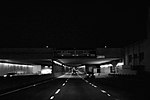Theme Building
1961 establishments in CaliforniaBuildings and structures completed in 1961Buildings and structures in Los AngelesCulture of Los AngelesGoogie architecture in California ... and 10 more
Landmarks in Los AngelesLos Angeles Historic-Cultural MonumentsLos Angeles International AirportModernist architecture in CaliforniaPaul Williams (architect) buildingsRetrofuturismTowers in CaliforniaUse mdy dates from September 2019Westchester, Los AngelesWilliam Pereira buildings

The Theme Building is a structure at Los Angeles International Airport (LAX), considered an architectural example of the Space Age design style. Influenced by "Populuxe" architecture, it is an example of the Mid-century modern design movement later to become known as "Googie". The Airport Theme Building Exterior and Interior was designated as a historic-cultural monument in 1993 by the city.
Excerpt from the Wikipedia article Theme Building (License: CC BY-SA 3.0, Authors, Images).Theme Building
World Way, Los Angeles
Geographical coordinates (GPS) Address External links Nearby Places Show on map
Geographical coordinates (GPS)
| Latitude | Longitude |
|---|---|
| N 33.9441 ° | E -118.4024 ° |
Address
The Theme Building
World Way 209
90045 Los Angeles
California, United States
Open on Google Maps







